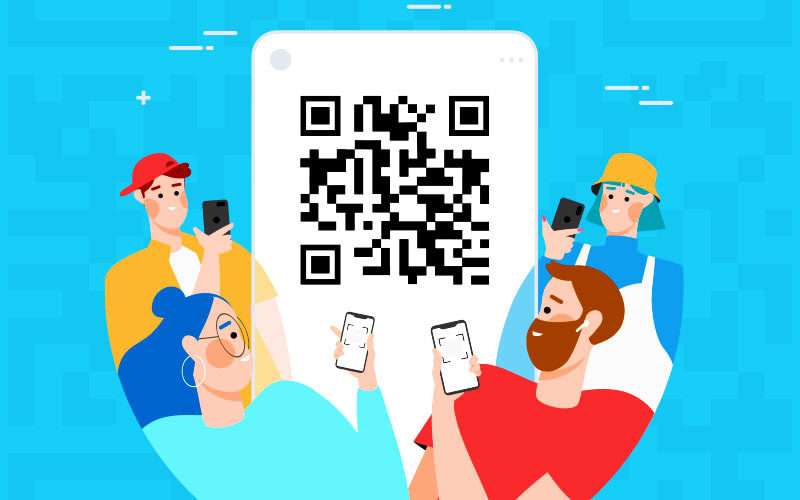The full form of the QR Code is the Quick Response Code. It is a trademark or a form of a 2D bar code containing a dot matrix. It was first developed by the Japanese automotive company Denso Wave in 1994 in Japan to monitor vehicles during development. Later, due to its easy readability and high storage space compared to conventional UPC barcodes, it became famous outside of the automotive sector.



History of QR Codes
- QR codes were invented in 1994 by Denso Wave, a subsidiary of Denso Corporation. They were initially developed for tracking automotive parts during manufacturing.
- Denso Wave released QR code technology to the public domain in 1999, leading to widespread adoption.
- QR codes gained popularity in early 2000s Japan, used for product labelling, mobile marketing, and contactless payments.
- As smartphones became common, QR code scanning apps made it easier for users to interact with QR code content globally.
- QR codes have been widely used in marketing, contact tracing during pandemics, mobile payments, and product packaging.
- They continue to evolve in design, functionality, and security and find applications in various industries.
- QR codes have transformed from a manufacturing tool to a versatile digital technology, offering convenience and efficiency in the modern world.
QR Code Applications
QR codes have diverse applications, including:
- Mobile Payments: Used in mobile wallets like Alipay and WeChat Pay.
- Marketing: Links to websites, videos, or promotions.
- Ticketing: Digital and physical tickets for events and transport.
- Contactless Menus: Access restaurant menus via smartphones.
- Healthcare: Patient ID, medical records, and prescriptions.
- Product Info: Detailed info on product packaging.
- Inventory: Efficient stock tracking for businesses.
- Education: Access supplementary content for learning.
- Contact Tracing: Vital during COVID-19 for exposure tracking.
- Tourism: Instant access to guides and maps.
- Security: 2FA and secure logins.
Creating QR Codes
Creating QR codes is a straightforward process, and there are many online tools and generators available for free. Here’s a step-by-step guide on how to create a QR code:
- Determine the Content: Decide what you want the QR code to contain. It can be a URL, text, contact information, WiFi credentials, phone number, or more. The content will determine the type of QR code you create.
- Choose a QR Code Generator: There are numerous QR code generators available online. Popular options include QR Code Generator, QR Stuff, and QR Code Monkey. Choose one that suits your needs.
- Select the QR Code Type: Most generators allow you to choose from various QR code types, such as URL, text, email, phone number, WiFi, and more. Select the type that matches the content you want to encode.
- Enter the Content: Enter the specific content you want to encode. For a URL, enter the website address. For text, type the message. For contact information, input the details accordingly.
- Customize the QR Code (Optional): Many QR code generators offer customization options. You can change the QR code’s colour, add a logo or image in the centre, and adjust the error correction level. Customization options may vary depending on the generator.
- Generate the QR Code: Click the “Generate” or “Create” button to generate your QR code. The generator will process your input and generate the QR code image.
- Download the QR Code: Once the QR code is generated, you can typically download it as an image file (e.g., PNG, JPEG). Save it to your computer or device.
- Test the QR Code: Before using the QR code in any materials or promotions, it’s essential to test it to ensure it works correctly. Use a QR code scanner app on your smartphone to scan the code and verify that it leads to the intended content.
- Use the QR Code: Once you’ve confirmed that the QR code works as expected, you can use it in various ways. Print it on marketing materials, posters, product packaging, business cards, or websites.
Scanning QR Codes
iOS (iPhone and iPad):
- Open the Camera app.
- Point at the QR code.
- Wait for recognition.
- Tap the notification to access the content.
Android Devices:
- Open the Camera app (or QR code scanner app).
- Scan the QR code.
- Follow on-screen prompts to access the content.
Dedicated QR Code Scanner Apps (iOS and Android):
- Download the QR code scanner app.
- Open the app, scan the QR code, and access content.
QR codes simplify accessing information and performing tasks with your smartphone or tablet.
Conclusion
In conclusion, QR codes (Quick Response codes) have become an integral part of our digital lives, offering a quick and efficient way to access information, perform actions, and streamline various processes. Their history traces back to the 1990s, initially developed for inventory management but later adopted for a wide range of applications.
QR codes have found utility in areas such as mobile payments, marketing, ticketing, healthcare, product packaging, education, and contact tracing during the COVID-19 pandemic. Their versatility and ease of use make them a valuable tool for businesses, organizations, and individuals.
Frequently Asked Question
A QR code encodes information as a pattern of black squares and white spaces. When scanned, a QR code reader interprets this pattern and retrieves the encoded data.
QR codes can store various types of data, including URLs, text, contact information, Wi-Fi credentials, phone numbers, and more.
Common uses include mobile payments, marketing, ticketing, contactless menus, healthcare, product packaging, education, and contact tracing.






